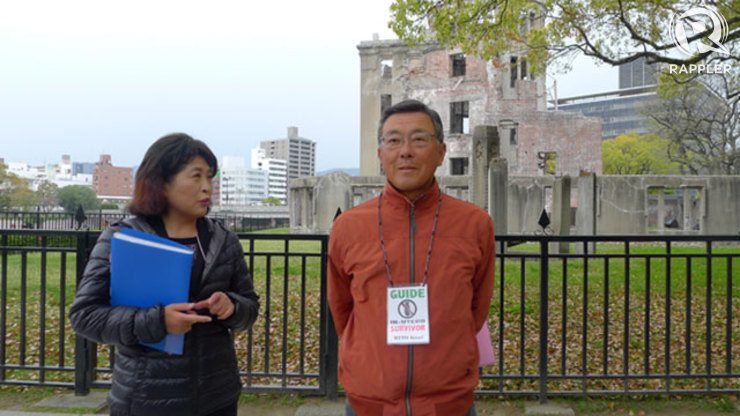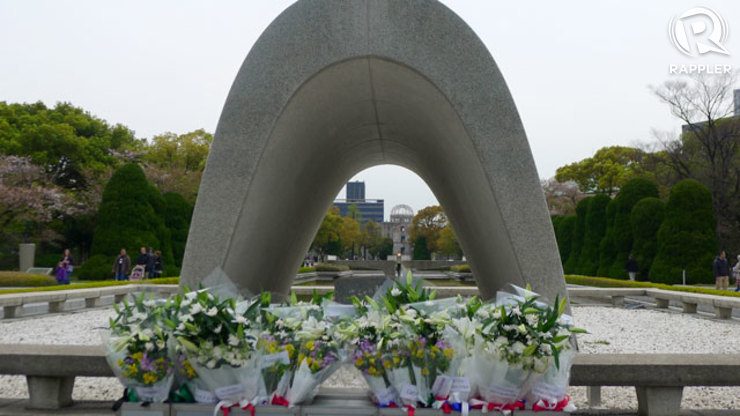SUMMARY
This is AI generated summarization, which may have errors. For context, always refer to the full article.
 HIROSHIMA, Japan – Their stories are heartwrenching.
HIROSHIMA, Japan – Their stories are heartwrenching.
The bomb exploded 600 meters (2,000 feet) above the city. With a smile, Michiko Yamaoka explained that was what the scientists in America calculated would create “maximum destruction.”
The explosive force travelled at a speed of 440 meters per second straight down before spreading out then rebounding back to the city. It sucked the air out, with initial searing temperatures between 3,000 to 4,000 degrees Celsius, and created “a vacuum that made people’s eyeballs pop out.”
Michiko Yamaoka showed us a picture of her aunt, who died in the atomic bombing of Hiroshima on August 6, 1945.
“Victims were carbonized,” said Yamaoka. Her mother fainted, and when she woke up, she looked around, and these were her words: “There are people covered in blood. Like ghosts, their skins peeling off.”
Emiko Okada was only 8 years old on the day the bomb dropped.
“We lived behind Hiroshima station, and it was a beautiful sunny day,” she told The National. “I saw a shining aircraft in the sky and then heard a loud sound and intense flash of light. I had no idea what happened but immediately saw my mum with glass fragments in her head, and she was bleeding.”
Okada’s 12-year-old sister died that day. Her family fled the city, which Hibakushas, survivors of the A-bomb, describe as a scorched wasteland seared into their memories. Those who are still alive today, nearly 70 years later, still live with its effects.
“Hiroshima turned into a city of death,” said Okada. “When I see the sunset, it reminds me of the red sky I saw when Hiroshima burnt so I don’t like to look at it.”
Okada lived with health problems her whole life, like gastric cancer, a constant fever, blood loss and fatigue. Because of the long-lasting effects of radiation, she passed on some of her sickness to her daughter.

There’s a group of volunteer Hibakusha guides at Hiroshima’s Peace Memorial Park, which holds the Genbaku Domu or the A-bomb Dome. Mito Kosei is the leader of the volunteer group and wrote his story, which he says he wants everyone in the world to hear “so that they will never allow this to happen again.”
Those words are echoed by Japan’s Foreign Minister Fumio Kishida. He is from Hiroshima, and when he invited the world’s leaders to his home town, it was personal.
“I want them to see what happened and why I have an especially strong sentiment to work for a world of nuclear disarmament,” Kishida told us after hosting 8 foreign ministers from the Non-Proliferation and Disarmament Initiative (NPDI), a group of 12 non-nuclear weapon states which Japan and Australia helped establish in 2010. It includes Canada, Chile, Germany, Mexico, the Netherlands, Nigeria, the Philippines, Poland, Turkey and the United Arab Emirates.
The foreign ministers, including Albert del Rosario from the Philippines and Julie Bishop from Australia, laid flowers at the Peace Memorial and spoke with Hibakushas.
.@JulieBishopMP visited the Hiroshima Peace Memorial & dedicated flowers at the Cenotaph for A-bomb victims. pic.twitter.com/BeBnIpvxMg
— Bruce Miller (@AusAmbJP) April 12, 2014
“Many of them mentioned that they were shocked,” Kishida said. “They were very moved by the experience. I believe it was meaningful for them to see the reality of what we went through. They will bring this to the international community.”
Free of nuclear weapons
The joint declaration they signed on April 12, 2014 committed their countries to work for “a world free of nuclear weapons,” adopt “a multilateral approach to nuclear disarmament,” and to “freeze nuclear forces at the present levels and start reducing their arsenals.”
The NPDI condemned North Korea’s nuclear and ballistic missile programs and urged “North Korea to refrain from further provocative actions,” including ballistic missile launches and “to cease all nuclear activities.” It also pushed for a speedy resolution of nuclear issues in Iran.
Parallel to the NPDI meeting, Asialink convened an ASEAN Track 2 dialogue with government officials, members of the academe and media. When Kishida spoke to us about showing leaders the lessons from Hiroshima, he was emphatic.
His message was echoed by Hiroshima’s Vice Governor Hironori Takagaki and other city officials. Hiroshima established a program called Mayors for Peace, which now includes 6,000 cities around the world demanding nuclear weapons be abolished by 2020.
Yasuyoshi Komizo, the secretary general of Mayors for Peace and chair of the Hiroshima Peace Culture Foundation, said there are still 17,000 nuclear warheads in the world from a peak of 70,000 during the Cold War.
“That means we’re still living in nuclear danger,” he said. “Nuclear weapons are only a liability, not an asset.”
When the bomb dropped on Hiroshima, it killed more than 140,000 people, 70,000 of whom died instantly. The Atomic Bomb Memorial Mound inside the Peace Park contains the ashes of 70,000 unidentified victims, many of whom, burned by the heat and radiation, threw themselves into the river after the explosion.
In 1995, I reported on the 50th anniversary of the bombing. Now nearly 20 years later, I still feel the horror when I hear stories of tens of thousands dying, parched with thirst. Outside the A-bomb Dome today are numerous plastic bottles of water, an offering for the dead.
When you visit ground zero at Hiroshima’s Peace Memorial Park and meet the Hibakushas, it’s striking to see an acceptance and a sense of mission. Perhaps in a bid to make their suffering mean something, Hiroshima is now leading the fight for peace, for nuclear disarmament and non-proliferation. That is how it made the tragedy it lived through have meaning and value for the world.
A privilege to meet A-bomb survivor Keiko Ogura in #Hiroshima and hear her story as an 8y/o on 6 August 1945 pic.twitter.com/PYiUmTAVml
— Julie Bishop (@JulieBishopMP) April 12, 2014
It’s also striking how Japan, the only country that’s lived through two atomic bombings, is now America’s staunchest ally in Asia.
“Well, we started the war,” Professor Narushige Michishita from Tokyo’s National Graduate Institute for Policy Studies told me. “So that kind of helped because we couldn’t blame the US for everything.”
Cold war realities helped Japan and the US move swiftly forward after the bombs fell on Hiroshima and Nagasaki.
“There was a consensus on both sides,” said Michishita. “The United States needed Japanese support in order to fight the Cold War with the Soviet Union. Japan became a major base of operations for the US forces, and the Japanese leaders knew that the Americans could help us reconstruct our country.”
Don’t repeat this evil
There was also a deliberate “blurring” of how Japanese officials referred to the bombings.
“There’s a very famous phrase used over and over ‘we will never repeat this mistake,'” Michishita said. “When we say ‘we,’ who are ‘we’? The question of who ‘we’ are in this context is blurred. So that ‘we’ can be us – Japan will not repeat the mistake of going to war again. ‘We’ can be Americans who will not drop a bomb on anyone else. Or ‘we’ can be humankind who should never make this mistake again.”
Japanese survivors like Mito Kosei point out that some realities of the suffering of Hibakushas have been left out of official accounts inside the Peace Memorial Park. The officially sanctioned presentation ends with a last slide that starts with, “Most survivors hate war itself not the American people. To learn history from the past is very important so that the same things do not happen again in the future.”
Komizo, the secretary general of Mayors for Peace, said at the beginning there was hatred and a call for revenge.
“They’re ordinary people,” said Komizo. “But over the years, they’ve come to the unshakeable conviction that nobody should suffer as they have.”
“We have to convey in an accurate manner the reality of what happened in Hiroshima so that this will never happen again,” said Hibakusha Emiko Okada. “When I look back, part of me doesn’t want to talk about it any more because I wonder why did we have to suffer like this?”
She called for more global action on nuclear disarmament and non-proliferation – words amplified by Japanese Foreign Minister Kishida, who wants the NPDI to jumpstart the 2015 Review Conference of the Treaty on the Non-Proliferation of Nucelar Weapons (NPT), which meets once every five years.
In the midst of all this activity is a nexus of silence at ground zero, an arch through which you can see the flame of peace, lit in 1964 and kept burning until nuclear weapons “shall have disappeared from the earth.” The arch is a cenotaph, an empty tomb to shelter the souls of nearly 222,000 names in its registry, people who died from the atomic bomb in Hiroshima.

The enscription says it all, a lesson Hiroshima wants the world to learn: “Let all the souls here rest in peace. For we shall not repeat this evil.” – Rappler.com
Add a comment
How does this make you feel?





There are no comments yet. Add your comment to start the conversation.